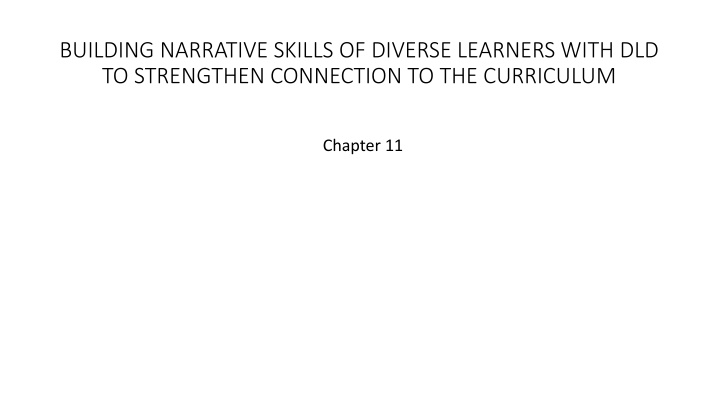
Strengthening Narrative Skills of Diverse Learners with DLD
Explore the importance of narrative skills for diverse learners with Developmental Language Disorder (DLD) and how it enhances their connection to the curriculum. The chapter covers essential skills for constructing narratives, differences in cultural storytelling styles, school expectations, and story grammar analysis. Discover strategies to support children with DLD in developing their narrative abilities, aligning with Common Core Expectations.
Uploaded on | 1 Views
Download Presentation

Please find below an Image/Link to download the presentation.
The content on the website is provided AS IS for your information and personal use only. It may not be sold, licensed, or shared on other websites without obtaining consent from the author. If you encounter any issues during the download, it is possible that the publisher has removed the file from their server.
You are allowed to download the files provided on this website for personal or commercial use, subject to the condition that they are used lawfully. All files are the property of their respective owners.
The content on the website is provided AS IS for your information and personal use only. It may not be sold, licensed, or shared on other websites without obtaining consent from the author.
E N D
Presentation Transcript
BUILDING NARRATIVE SKILLS OF DIVERSE LEARNERS WITH DLD TO STRENGTHEN CONNECTION TO THE CURRICULUM Chapter 11
II. SKILLS REQUIRED FOR CONSTRUCTING NARRATIVESKNOWLEDGE OF:
Common Core Expectations (not on examp. 406)** Kindergarten: Use a combination of drawing, dictating, and writing to narrate a single even or several loosely linked events in the order in which the events occurred and provide a reaction to what happened. Third grade: Write narratives to develop real or imagined events using effective technique, descriptive details, and clear event sequences. Introduce a situation and a character. Use dialogue, actions, thoughts, and feelings to show character response, along with temporal words and closure.
V. STORY GRAMMAR ANALYSIS A. Foundations
B. Young children show pre-episodic organization:** Collection of utterances loosely linked by a theme or temporal order Earliest type of pre-episodic organization is a descriptive sequence; there is no real order or temporal relationship Action sequence: series of actions that show temporal relations (first A happened, next B happened, and finally C happened) with a beginning, middle, and end
For example:** (not on exam) The boy s family moved to a new state because his mom changed jobs. He was lonely because he didn t know anyone. He talked to his parents, and they told him to ask kids on the playground if he could play with them. He did this, and made some fun new friends at school.
VI. INTERVENTION** A. Foundational Concepts There are both expository and narrative books Narratives tell a story Expository books provide information
Lets have you do this nowdraw pictures for going to get a child from the classroom and bring them to speech and have them sit politely at the table We actually did this in my job with some very rowdy TK boys and it worked great!
Use props** Puppets Flannel graph Velcro pictures
Cohen-Minran et al. An activity-based language Early Childhood Education Journal, 44, 69-78. ** This retrospective study examined the effect of small-group intervention with 220 Hebrew-speaking children ages 3-5 years They were Israeli and low-income and had low language skills, especially vocabulary. Narrative skills were compromised also. The question: did children in the preschool program show greater increases than controls who didn t enroll in the program?
Cohen-Minran et. al.:** (dont worry about numbers for the exam ) SLPs saw children in their classrooms in small groups once a week for 7 months Each classroom had 30-35 children, and they were divided into groups of 5-6 to work with the SLP 6 sessions per book (total of 3-5 books during the 7 months)
Cohen-Minran et al. in sessions 3-6:** 1) Planning phase pictures used to introduce activity, SLP talked about how to carry out the activity (e.g., for a book about fruit, making a fruit salad) 2) Experiencing phase children cut the fruits 3) Reconstructing phase SLP used pictures to allow children to re-tell the activities they d done
Cohen-Minran et al. --In comparison to control group who did not enroll in the program, the experimental group:** Scored significantly higher on vocabulary measures and sentence imitation tasks
VII. IMPROVE VOCABULARY** The more words students understand and can retrieve, the better their narrative skills will be
Levin et al. Evaluating the effect of rich vocabulary instruction and retrieval practice on the classroom vocabulary skills of children with DLD. Language, Speech, and Hearing Services in Schools, 53, 542-560.** (review) In this study, they taught new vocabulary to 11 Swedish- speaking students with DLD (average age=14 years old). This was done in the students classrooms as part of their scheduled lessons in Swedish. They presented 20 Tier 2 words under 2 conditions
Levlin et al.found that rich practice (RP) was most effective; RP is characterized by:** 1. Teacher summarized the gist of the story orally while presenting pictures supporting the main content. 2. Teacher read the story out loud while the text remained visible on the interactive board. 3. Teacher provided a detailed, student-friendly definition of the target word showing on the board. 4. Students had to answer multiple choice ?s
Levlin et al. continuedRP:** 5. Students had a paper where they had to draw a line from the target word to its corresponding definition 6. Teacher provided a definition and students wrote the corresponding word on paper Subsequent lessons were similar and contained review of previous words taught
Pena & Bedore (2024). Books provide full language story to bilingual students with DLD. The ASHA Leader (March-April 2024).** They recommend a program called Reading A to Z which offers materials in Spanish, French, Ukrainian, Vietnamese https://www.learninga-z.com/site/products/readinga- z/overview?utm_source=google&utm_medium=cpc&utm_campaign=US- BRD&gad_source=1&gclid=CjwKCAjwnK60BhA9EiwAmpHZw8prJOltnfvX- CxuOAS5vapU0IWabq5STSJC1c5D_sKwm5FdzenX0RoCuowQAvD_BwE
Pena & Bedore 2024 use books that connect with classroom curriculum to help promote cross-language transfer between Spanish and English:






















